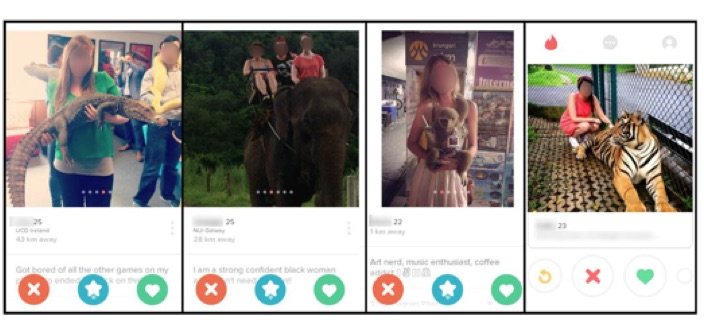Swipe Left For Tinder Tigers
I am a zoologist and conservationist. Most of my short career has been focused in Southeast Asia, namely Indonesia. Indonesia is endowed with breath-taking landscapes and rainforests bursting with diverse wildlife. Over the past few decades, those natural riches have been bombarded with attacks from a fast-growing population, agricultural expansion, and international demand for forest products like timber. Indonesia has lost 25% of its forest cover in the last 25 years, and deforestation is still occurring at a completely unsustainable rate. The remaining forest refuges—even those that experience little or no deforestation—are hit by another, much darker, form of exploitation: the extraction of wild animals for the wildlife trade. A similar trend is occurring in most tropical countries in the world.
So what has any of this got to do with Tinder? For those of you who don’t know, Tinder is a popular online dating app in which people flick through photos of each other and if both people “like” the others profile, they are “matched” and can then chat, arrange to meet up, never acknowledge that it happened, or whatever else they see fit. There is also a blurb under each person’s profile so you can get some small idea of who they are, but the photos are very much the centrepiece. I was first convinced to try the app while I was working in Indonesia; since I arrived home three months ago, I have been using it in Ireland too.
The two most important things I have learned from Tinder are:
- I am less attractive in Ireland than I am in Indonesia. Either that, or Irish women have terrible taste in men. This is highly unlikely but it helps me sleep at night.
- Many Irish women, especially those who have travelled to Asia, are fueling the booming wildlife trade that threatens the survival of many species around the world.
In my three months Tindering on home soil, I have seen 2 women photographed with gibbons, 15 women photographed with macaques, 2 women photographed with marmosets, 3 women photographed with koalas, 6 women photographed with dolphins, 10 women photographed with snakes, 12 women photographed with kangaroos, 20 women photographed with camels, 52 women photographed with tigers, 72 women photographed with elephants, and many others photographed with various species of reptiles and birds of prey that I cannot identify. There are probably many more; I only look at roughly 10% of the photos. The animals in these photographs, unbeknown to the women involved, are part of the “photo-prop trade”. Of course women are not alone in this and there is even a tumblr feed dedicated to the ridiculous and irresponsible trend of the men of tinder who pose with tigers.
The illegal trade in wild animals, both dead and alive, is a lucrative business. Animals are traded for a range of uses. The pet trade, the traditional medicine trade, the bush meat trade, the ornamental trade, and the performing animal trade are some of the leading culprits. It is a trade of almost incomprehensible scale that is worth billions of dollars, with millions of animals of every type being traded each year. There are national laws and international agreements that regulate the trade but a lack of resources and deep-rooted corruption mean that much of the trade goes unmonitored.
One of the least-studied drivers of the illegal wildlife trade is the photo-prop trade, whereby animals are used as props for tourists to pose with in photographs. Small-scale operations exist in the form of street merchants offering tourists the opportunity to pose with an exotic animal for a small fee. Larger-scale operations like the notorious Tiger Temple in Thailand’s Kanchanaburi Province discussed previously on HeadStuff Science have transformed the trade into a multi-million-dollar business. The Tiger Temple and many other sites operate under the guise of an animal sanctuary which tourists can visit and have close animal encounters, their entrance fee supposedly being pumped back into wildlife conservation. However, several of these projects have been implicated in animal cruelty and the illegal trading of live animals and animal parts.
The typical path from the wild to whatever the animal ends up being used for is fraught with danger and suffering. For every one animal you see on the street, many will have died. Most animals are captured young, so oftentimes their parents will be killed in the hunt. The young animals can be accidentally killed in the hunt from misjudged gunshots or falling from trees. Further deaths occur due to improper care, physical abuse, and stress during transport. If the animals make it through all this, many will die from stress, physical abuse, and starvation.
Several recent studies argue that women are more susceptible than men to the “cute factor” of certain animal species and have an increased desire to have physical contact with them. Women are seen on Tinder with a wider range of cute animals while males tend to stick with animals that might be classified as ‘macho’ like tigers. There is a small (and hopefully growing) group of users who oppose these photographs. I was pleased to see the profiles of three women that expressed their distaste with this trend, saying they will not match with any men featuring exotic animals in their Tinder profiles.
Perhaps the most worrying thing about these photographs is they seem to be something that people think showcases a part of their attractiveness. You can only use a maximum of six photographs on your Tinder profile, so most people will carefully choose photographs that demonstrate their physical attractiveness or tell something about their personality. In the case of photographs with exotic animals, the intended message is probably a combination of a love of travelling, a love of animals, and an adventurous nature. It may well succeed in getting this message across for the majority of people, but for those who know about the wildlife trade, it only showcases a lack of knowledge that leads to the suffering and death of many animals.
So, is getting your photo taken with an animal always bad? The answer is no, but there are few factors to consider before you do. If you are offered the opportunity to be photographed in physical contact with an animal and there is money involved, there is probably something wrong. Some sanctuaries are only posing as sanctuaries for personal profit. Do a little research online on the sanctuaries you visit before you go (you can find some more examples of reputable sanctuaries here). It doesn’t take long. If you really want an authentic wildlife experience, there are plenty of responsible ecotourism projects all over the world. These range from safaris, to guided tours in forests. A good ecotourism project provides economic benefits for local people, promotes the value of wildlife in a wild setting, and allows tourists to have unforgettable experience without any animal cruelty or death. You may even be able to get a snap (if you don’t use flash and maintain a safe distance) with you and a wild animal in same frame. That photo will mean so much more than any of these photo-prop travesties. It will show more about more your adventurous, charitable, and animal-loving nature than they ever could. It makes for a better story too. If you are really feeling adventurous and want to do something good, it may be possible to do some short-term volunteering with a conservation organisation.
Just in case you need another deterrent from taking photographs with exotic animals, two recent studies found that animals photographed with humans, or simply in human settings, are more likely to be perceived as being less threatened in the wild and more desirable as pets. This means that the photo-prop trade is undermining wild populations on several different levels.
The last thing to consider if you publish these photos on social media is context. Accompanying each photograph, should be a backstory and information about how the animal in your photograph is not part of the illegal wildlife trade. If you can’t provide the backstory, you probably shouldn’t have taken the photograph. Providing context makes the photo more interesting and promotes responsible ecotourism. Spreading the word and changing people’s attitudes can bring the whole horrible business to its knees. No consumers, no money, no business, no trade. Be responsible and have a nice trip.


